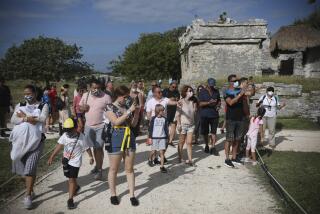American Culture Engulfs Guam
- Share via
AGANA, Guam — Move a typical sleepy middle-American town to the middle of the Pacific Ocean. The result could be the island of Guam.
Fast-food chains such as McDonald’s and spacious shopping malls dot the landscape. Sports cars race down Marine Drive as if it were a California freeway.
But some on this south Pacific island are not content with the hamburgers, milkshakes and gun clubs catering to hundreds of thousands of Japanese tourists yearning for a taste of the U.S. Wild West.
Native Chamorros who call Guam and the Northern Mariana Islands home are worried the pervasive U.S. influence will eventually overwhelm their culture and language.
“American colonialism is tearing our nation apart,” said David Lujan Sablan, a 44-year-old Vietnam veteran and artist who has renounced his U.S. citizenship to support his call for the island to be given more control over its affairs.
“We Chamorros are doomed to be slaves in our own land to the United States,” said Sablan, whose head is shaved, leaving only a tuft in the traditional Chamorro male hairstyle.
Jose Leon Guerrero, an education professor at the University of Guam, fears the next generation of Chamorros is rapidly losing the ability to speak the native language, a lyrical combination of Spanish and Polynesian.
Many children speak a combination of Chamorro and English and have difficulty understanding the purer version of the language spoken in the Northern Marianas, he said.
“It sounds like pidgin Chamorro and the kids laugh when they hear themselves say it because of the wrong grammar,” one elderly Chamorro said. “It’s worrying.”
“The Americanization of the people has something to do with it. Look at me, I can read Chamorro but I cannot write Chamorro. If you lose your language, you’re going to lose a chunk of your culture,” Guerrero said.
Lt. Gov. Frank Blas said the government is trying to reverse the trend by encouraging a renaissance of the Chamorro language and culture and an end to decades of neglect in the island’s schools.
Bilingual programs are being implemented, a Chamorro language commission is being set up and cultural shows are being sponsored to boost awareness of the island’s heritage, he said.
Sablan is not optimistic. He believes his people “are going to be in deep trouble” as more migrants from the Philippines flood into the island.
Filipinos now make up a third of the 140,000 people in the U.S. territory, about 1,500 miles east of the Philippines. Chamorros constitute about 40%.
Demographic officials expect the Filipinos to become the biggest group by the year 2010 as migration of Chamorros to the United States increases.
“The Chamorro people and culture will slowly become extinct,” Sablan said. “If it was up to me, I would choose independence for Guam,” he said.
But one official who declined to be named said it was too late to win independence or some other form of self-rule for the Chamorros.
Few want to rock the boat, fearing a messy battle over independence might scare away the Japanese tourists who pump more than $1 billion into Guam’s economy each year.
“Self-rule is something we could have fought for 20 or 30 years ago,” the official said. “(But) everybody is satisfied now with the way things are going. Nobody is thinking of independence anymore.”
More to Read
Sign up for Essential California
The most important California stories and recommendations in your inbox every morning.
You may occasionally receive promotional content from the Los Angeles Times.













